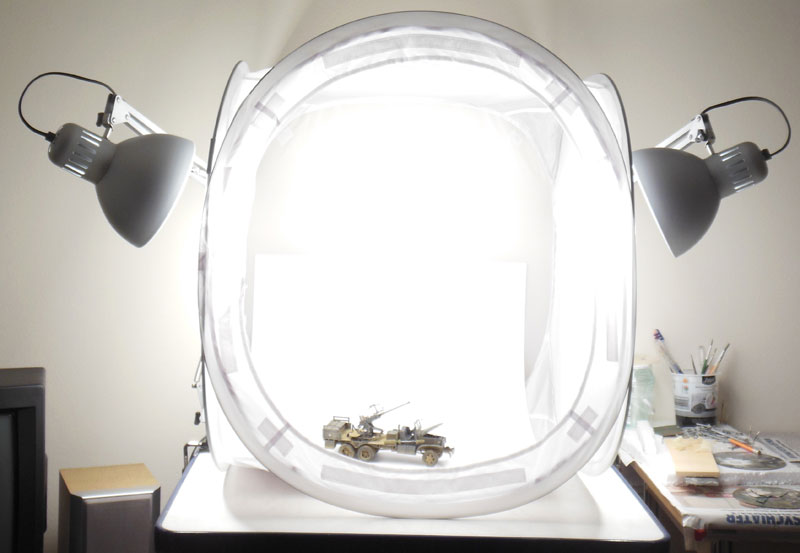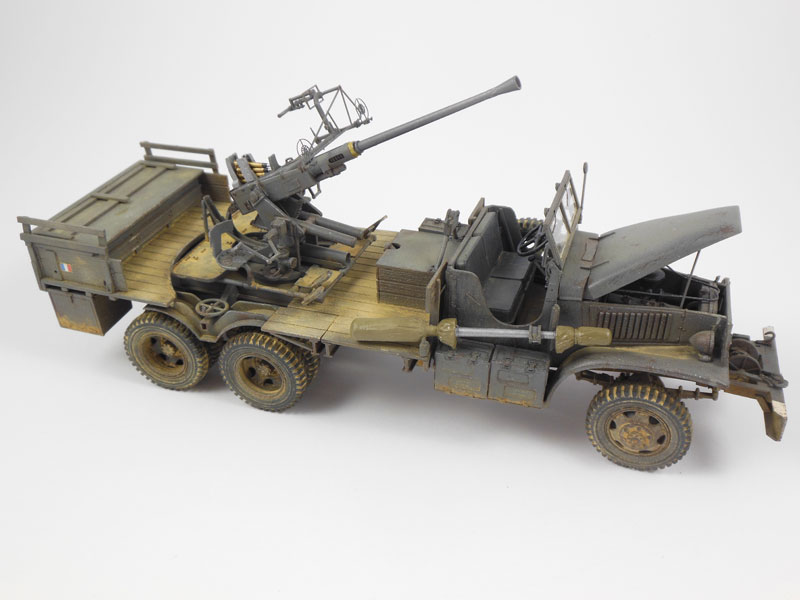Some basic ideas:
Tripod Nice but a good one is COSTLY. Say 130€+ for a Manfroto and that is only a middle class one. Check if you need it for more than taking shots of your models while indoors. If not - get a cheaper one. A decend low end Cullmann or Mantona (Manfroto copy) can be bought at 30-50€ if you shop around and is "good enough" for indoor use(1). The Benbo looks like really nice one, but starts at 200€ for the complete unit with head/quick mount.
A tripod will definitly get right of high ISO (at least with a DSLR) since you can set exposure time to 30sec if you need (or even more in certain modes) and that will make night into day at 100iso.
Light The question here is "what do you want"?
Your setup is the classic "sell it on ebay" shot aiming at reducing/eliminating shadows. In your current setup the paper diffusors definitly eat too much light. A light tent as recommended by Robert is definitly a better alternative. Again costs will vary and depend on how much space you have since the cheaper ones do not like constant set up/take down
An alternate setup is "simulated sun" with a single light source set up above/to the side of the kit. Totally different aims and that works with a light box (Starts at 60€). There you will get (and want) shadows. This is a lamp mounted in a reflector and behind a white diffusor. Versions that use a flash also exist.
Whatever light you use make sure that all lamps have the same (and constant) color temperature. And if you can get one that has a spectrum close to daylight go for those. They'll cost more, even worse in LED!
Flash AHAA..
Well okay, not the Dolph Lundgren movie but a carefully used external flash or three is an alternative light source. A DSLR can control multiple flashes so you can achive a similar light setup as in your example without permanent light. The setup costs a bit more, Yognuo Flashes start at 50-70€/piece depending on what you want. It's called Strobist. If you plan on a DSLR and using flash for any pictures you'll want an external flash anyway rather quickly(2)
Camera Canon user myself, first a 1100D entry level now a 60D prosumer so can not say much about Nikon/Sony/Pentax.
Even a used entry level DSLR with 12MP like the old 1100D is good enough for model shots. And if shooting kit is your main target take a look at high end compacts/bridges as well, cheaper and less of an addiction factor(3). Same for the lens, you are using a tripod so for the start the kit lens (typically an 18-55mm with a minimum 4-5.6 f-stop) should be good enough, just add some exposure time. And at least with Canon the current kit(s) are very good and cheap if bought with the cam
Depth of field control gets better, the bigger the sensor is. The inverse is true for price. An entry level 36mm DSLR comes in at 1600€ new, a more common entry level APS-C (22.5mm) at 350€. That is a lot of glass one can buy for the difference.
Lens Lens over body is the common tip when buying DSLR. A good lens on a low end body is better that the other way round. Boy was I supprised what my old "Chinese pig" could do when I put it on the 60D. Do not ditch the kit(4) but if that is not good enough for you, there are two schools for "next lens".
a) Prime lenses
Primes only have one focal length (say 50mm) and generally are lighter and often faster. F-Stops 1.8 or better can be had and for 1/5th the price of a f/1.8 Zoom. The offer the shortest depth of field since the smaller the f-Stop the bigger the lens opening (It's actually a fraction so 1/1.

and the smaller the DoF. But you pay for that with reduced comfort and/or needing more than one lens. And GOOD primes can easily cost 350€+
b) Zooms
The best affordable zooms are f/2.8. Anything better starts at 600+€ if you can get it at all. And the 2.8er can get heavy. Still they offer a decend control over the DoF and a lot of flexibility. If you can get and afford one(5), get a stabilised lens (Unless your camera has a build in stabiliser, one camera family has).
Me, I went zoom and did not look back. Partially because Canon primes are either C&A or costly as hell.
Makro A makro lens is often on the shopping list. Before you go there check if you have more uses for it than shooting kit. Otherwise try a set of screw-on makro lenses. They are often enough for the task and the cost a lot less.
Shoot RAW If the cam can do it (and some upper end compacts can) shoot in RAW or digital negative format and "develop" on your computer. This allows for change of white balance and other processing without loosing quality. The pictures need more storage space but you have total control over the outcome.
Think about Lightroom While cameras come with a RAW processor, I have found that Lightroom (I use 5.x) is a lot better at developing the shots and gives me quite a few more options than the cam supplies DPP software (that is not bad in itself btw). And as soon as the lens reads "Tamron/Sigma/Tokina" the vendor supplied program will no longer be able to correct for the lens profile(6) since they lack the data. Lightroom has. Free alternatives (Lightzone i.e) exist but even a miser like me switched to LR after two weeks of side by side testing. It was the dark side (and I got cookies

)
(1) I use a Cullman Primax 180 that I got for 28€ in a sale. Works nicely for a 2kg Kombination of DSLR and Lens (The system is rated at 3.5kg)
(2) The internal one is a) to weak b) only flashes straight ahead and c) has problems with certain lenses/flare protectors
(3) I bought the 1100D and the 18-55"Kit" lens for "shooting models" and "occasional museum pictures". No further lenses etc. planned. Two years later fotography is a major hobby of mine, I own four lenses (and plan on two more), a new (well used) body and...
(4) With current gen Canons the STM series is the kit lens to go for since it works well for taking videos.
(5) Stabilised 70-200: 1200€, unstabilised: 500€...
(6) And some 3rd party lenses are a better price/capability choice or even flat out better than the vendor ones. A Sigma Art 50/f1.4 beats the Canon counterpart like a Ferrari racing a Model T.


















